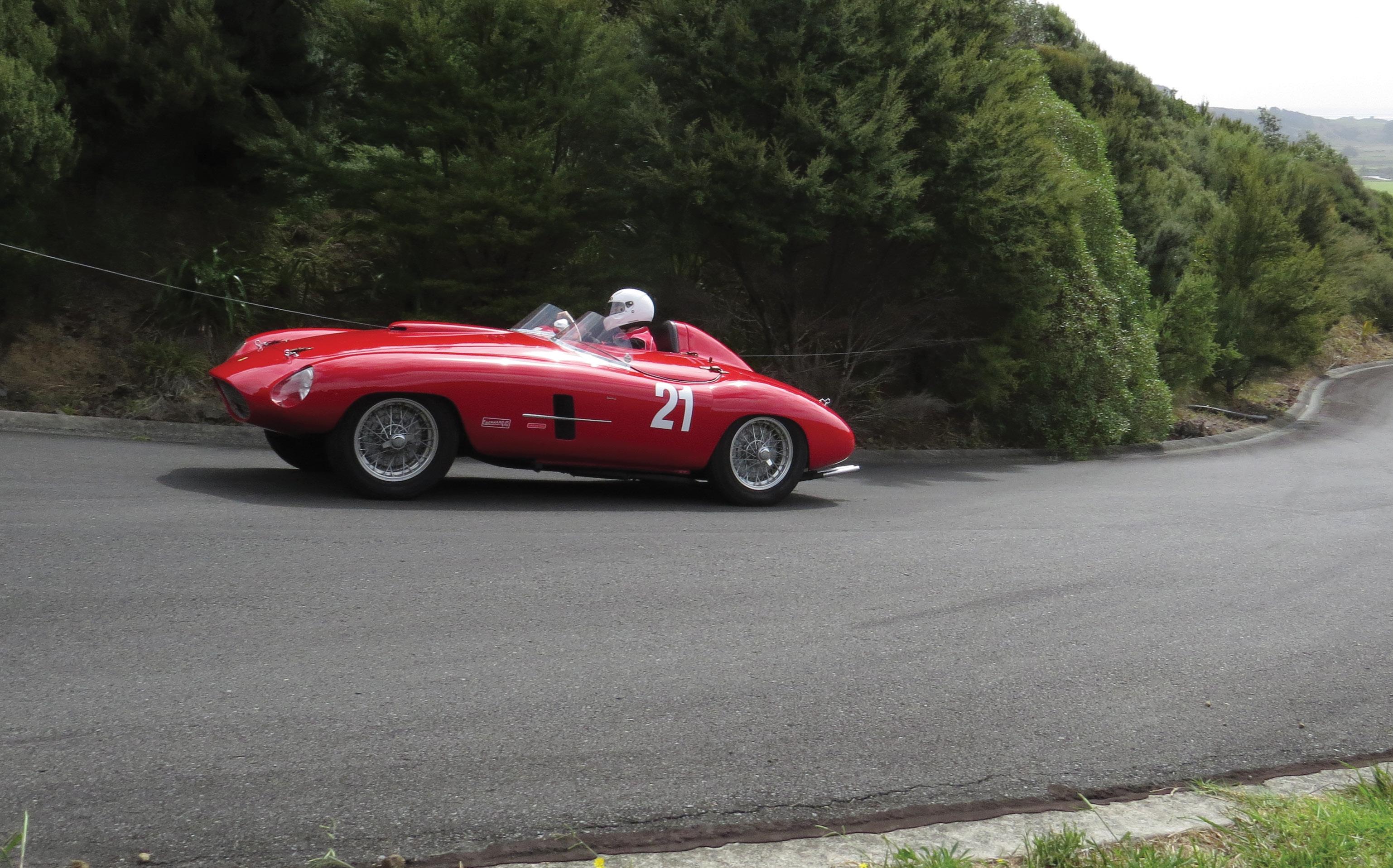
5 minute read
Stirring the Seven Senses
THE MANUNUI COASTAL HILL CLIMB
WORDS KEVIN BEESLEY
This speed event, staged jointly by Waitemata Branch and the Historic Racing and Sports Car Club, with timing assistance courtesy of the MG Car Club, catered for all the senses.
The pleasantly rural Manunui Coastal Estate, a lifestyle retreat near Pakiri about 70 minutes drive north of Auckland, offers sensory reward enough with or without the presence of historic motor vehicles. North facing on the side of the ridge rising behind the Pakiri settlement, with bush clad slopes and stunning views over rolling green farmland out to the white sands of Pakiri Beach and the ocean beyond, it is a glorious location for a hill climb.
Generous cloud cover on 28 March, the day of the contest, held the temperature down to a pleasant level, and a stiff breeze from the north-east was fresh with the salty tang of the nearby coast.
The course is over about 1.2 kms of the tar sealed road into the estate, rising about 100 metres in elevation through a series of corners and gradients. It is challenging, and testing of each competitor’s sense of balance and orientation. Immediately from the start line the road ascends steeply for 250 metres or so, then veers sharp left into a modest decline before a sweeping right-hander of increasing severity, then .onwards and sinuously upwards to the finish.
“We are aiming to get four runs in,” declared Max Jamieson, Clerk of the Course, at the drivers’ briefing. That may not sound many, but there were 31 contestants to get through, which requires a pretty slick operation. Waitemata are quite good at this sort of thing and activities progressed smoothly, despite a minor hiccup early on with the timing gear.
In the end, three runs including the practice were undertaken. Time for the fourth run was curtailed by a delay in proceedings during the third following an unscheduled departure from the course by Peter Boel in his 41C Lotus, and the location of an unfortunate tree that impeded further progress. Peter could take some consolation, though, from the excellent time of 61.85 seconds he posted on his second run. The Lotus was rather crumpled. The fate of the tree is uncertain.
Shortest time of the day went to Nigel Russell in his 1960 1098cc Sadler SJ. Nigel’s sense of proprioception was jolted somewhat about two thirds into his practice run when he slid off the road, ran through a coprosma bush and over a large rock it was
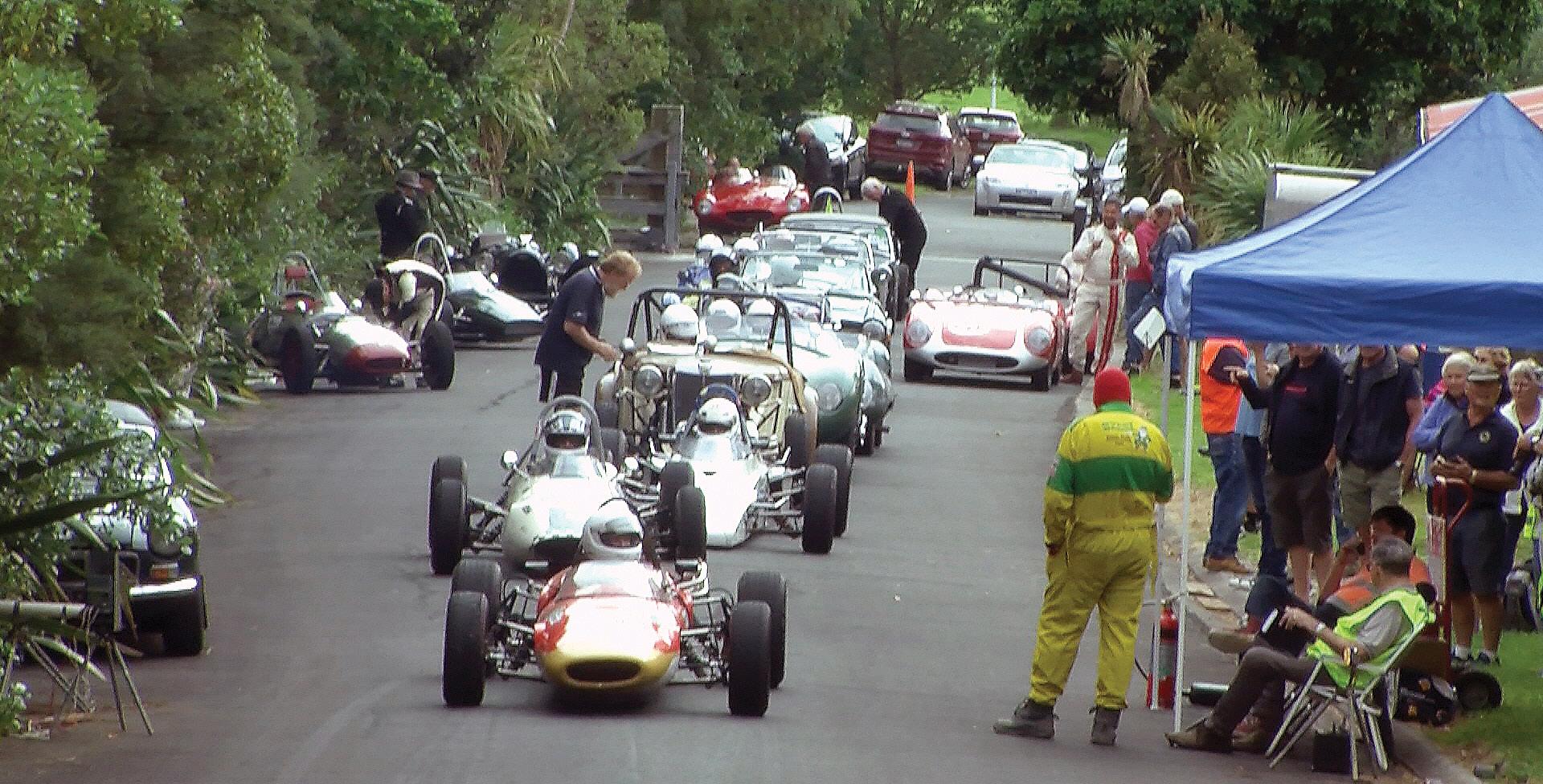
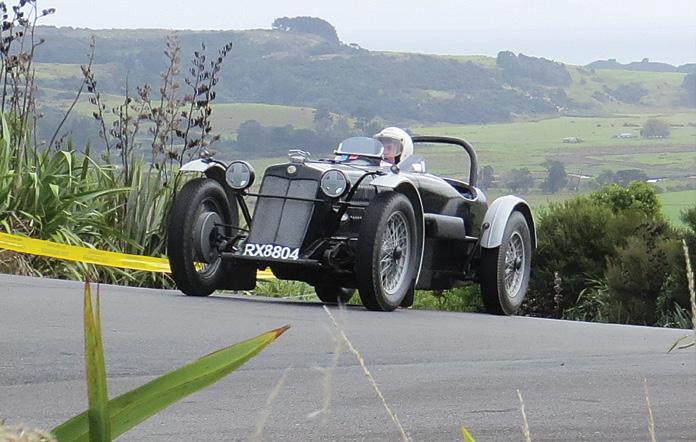
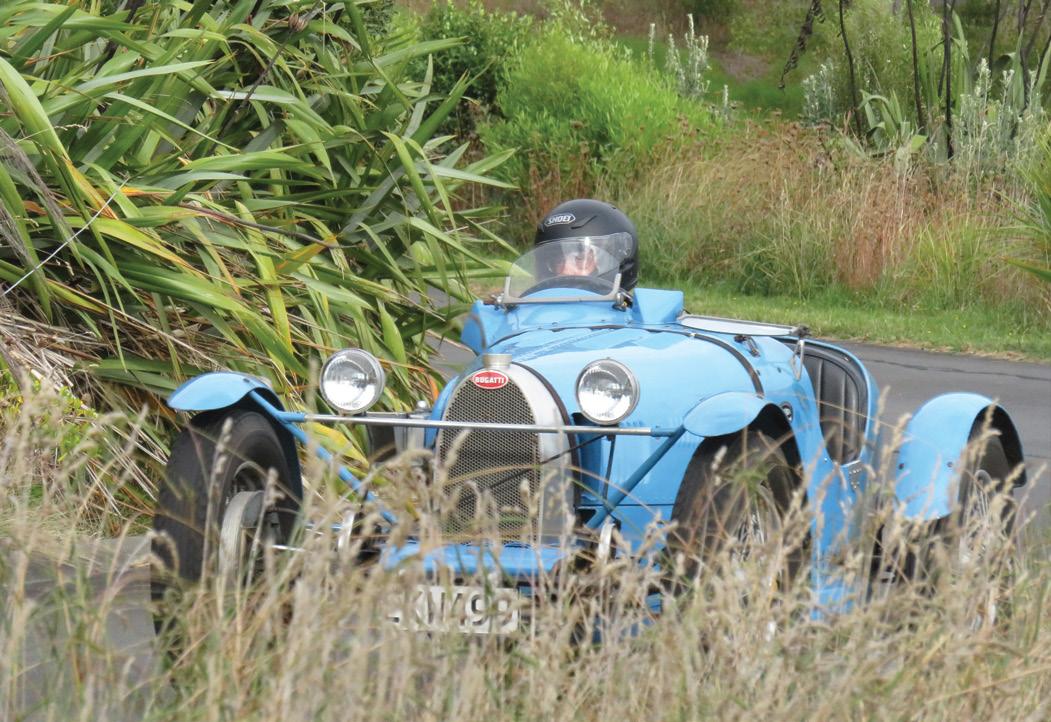
There was no sparing of the prancing horse. The 1953 166MM Ferrari at play. Photo: Jacqui Goldingham. Terry Roycroft and Bugatti Type 35A in rural setting. Photo: Stuart Elliot.
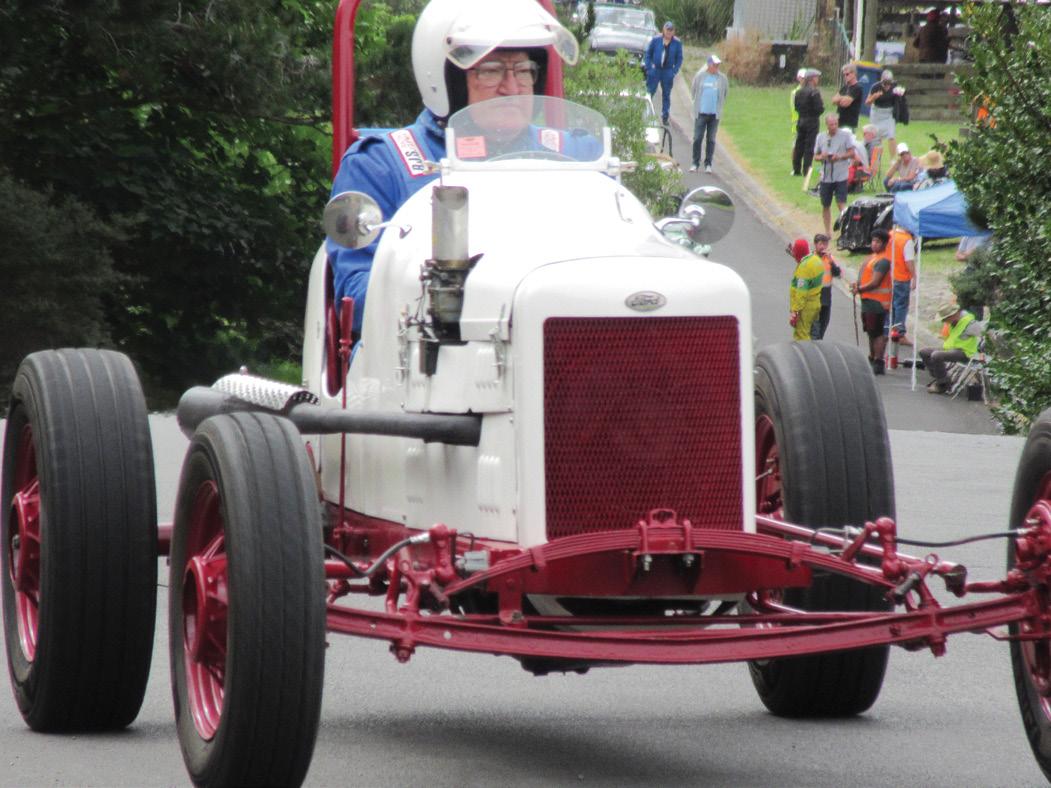
s Mike Courtney fires away in the Ford. Photo: Stuart Elliot. s Cresting MG. Lawrence Poolman and his 1934
Special. Photo: Jacqui Goldingham.
s Ray Ferner relaxed in the 1931 BSA.
Photo: Geoff Austen.
s Kevin Andrew, J2 MG and the start crew.
Photo: Geoff Austen.
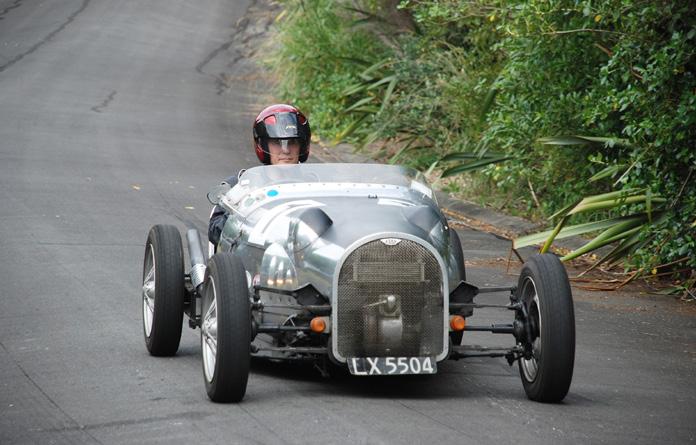
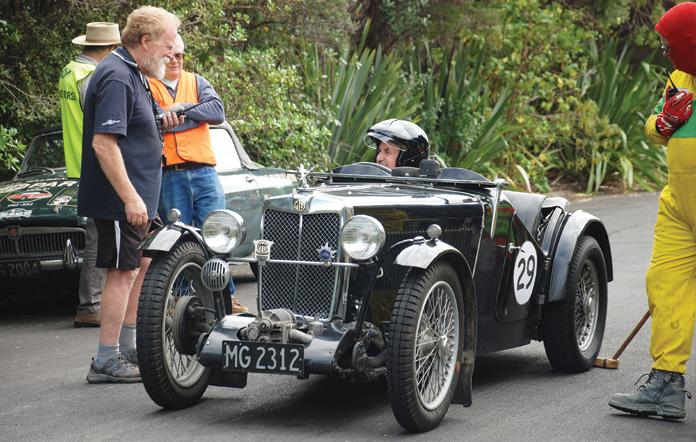
concealing. This was a moving experience for the rock, which was displaced several centimetres from its original position, and a removing one for the Sadler’s left hand front wheel, which found itself separated from the rest of the vehicle.
The powers that make motorsport their care move in mysterious ways, though. Soon thereafter, Steve Sharp and his Lotus 7 made a similar excursion through the same long-suffering coprosma and, missing the rock because Nigel had shifted it, Steve went on to register FTD at a course record 57.84 seconds.
Chris Fraser came in second, he and his 1975 Lola T342/FF achieving 60.39 seconds, a tad over his event winning 59.07 seconds at this hill climb last year. A whisker behind in third place at 60.46 seconds was Tony Olissoff in his diminutive 998cc Emeryson Elfin.
Fastest VCC car was Ralph Watson’s wonderful creation, the much modified, rotary valved 1931 BSA FW32, which, in the capable hands of its now owner Ray Ferner, proved what a formidable competitor it is, coming in at 62.02 seconds. The auditory impact of this vehicle as it exploded away from the start line endowed the word “blat” with a whole new dimension.
Hamish Andrew in 1958 Speedex Silverstone, Peter Benbrook in 1959 Gemini Mk 2, John Hudson in 2002 BMW and Noel Woodford in Gemini Mk3A all posted commendable times.
When it comes to good times, though, the prize went to Rob Scott, who was on his maiden event in his 1939 Austin Big 7 Special, a project that has been many years in the realisation. Also noted with large grins were Brendan Lamain campaigning his Triumph TR6, Rob Moston in the always well-presented C Type Jaguar, Graham Brayshaw at the wheel of his trusty 1954 Mk 6 Buckler, Lotus 11 mounted Tony Bushell, and Morley Faulkner in his delightfully sculptured 1964 Triumph Spitfire.
Mike Courtney’s 1936 Ford Model A ‘CeeGeeEss’ look-a-like and Rod Rattray’s ’63 A40 Farina added variation and although poles apart in every way, registered similar performances.
MG was the most numerous make, being ably represented by Lawrence Poolman’s 1934 Special, Kevin Andrew’s supercharged J2, and models B, Midget, TD and TC.
The sight and sound of Lionel Roger’s Type 59/50S Bugatti is certain to thrill those privileged to witness this magnificent vehicle in action and, with Robert McNair campaigning it this time on Lionel’s behalf, it did not disappoint. Robert blasted off the line in fine fashion but diplomatically ensured his fastest time, at 77.19 seconds, was suitably below Lionel’s best last year of 68.60 seconds.
Terry Roycroft’s 1925 T35A Bugatti, however, retired hors de combat after displacing an element of its suspension.
As to sense of touch, the exquisite 1953 Ferrari 166MM Scaglietti of Warren de France takes the cake. This gem is the real deal and of such beauty, such shape, as to be positively tactile. You know you shouldn’t, but you want to stroke it, to run your hands over its curves. It burbled quietly up to the line then growled purposefully as it accelerated away. Despite its provenance, Warren didn’t spare the prancing horse. A joy to behold.
It requires considerable planning and effort, but the location is a winner. Waitemata Branch will be doing what it can to restage the Manunui Coastal Hill Climb and stir the senses again next year.







